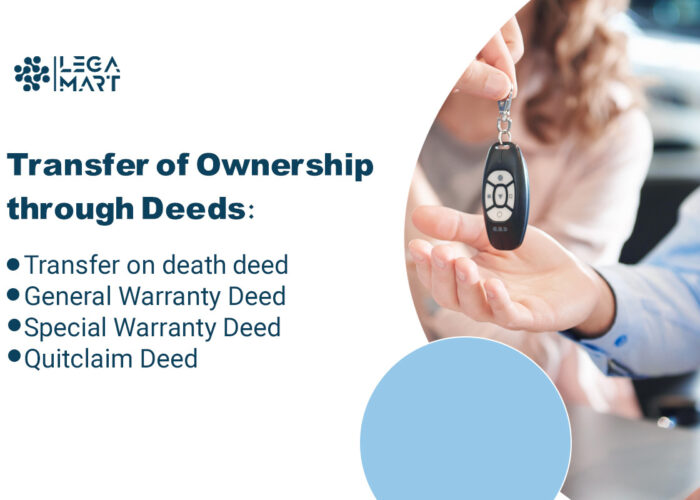Introduction
Property ownership and transfer of that ownership is something that everyone goes through in their lifetime. Therefore, it becomes imperative to understand the best ways to conduct the procedure, especially when the case is regarding the transfer of ownership among family members. Transferring property ownership in the US to family members is an exciting question, considering many people don’t find it essential to understand the legal technicalities of the process when a transfer takes place within the family.
Therefore, this blog discusses the various ways to transfer property ownership in the US to family members and the most convenient way to transfer property ownership and all interests to the respective family members.
Transfer Property Ownership Laws in the US
The United States laws, in general, are divided among three essential criteria – federal, state, and local. While these are the basic 3 levels of laws, however, it is possible for additional levels of laws to be available at the local level, depending upon the local jurisdiction. Now, when it comes to laws related to transfer property ownership, the common law prevalent in the US is considered. This law is usually a ‘judge-made law’ and is hence, dependent on the decisions taken by the judges.
When it comes to land ownership in the US, the ownership is given to the person having adequate title over the land. Therefore, it is the land owners’ responsibility to use the land and conduct any transfer related to it in accordance with the applicable federal, state, and local laws.
There are various ways to transfer property ownership in the US to family members. Some of them include the following:
Gift
Transferring property ownership through gift means that a person gives either partial or complete ownership over the property to their family member without any consideration involved. Therefore, the person gifting the property does not earn the value of the property and undertakes a generous act of giving it to the family member. However, it is essential to note that while gifting the property is very generous, the government can still impose taxes on the gift.
This is because you are required to file Internal Revenue Service (IRS) Form 709 and report the gifted property. It is important to note that as of 2022, gifts within the threshold of $12.92 million have been exempted from paying federal taxes. However, the person might still be liable to pay adequate capital gain taxes, as may be applicable to the property in consideration. This, too, might be resolved if the person chooses to transfer property ownership at their personal loss to their family level, in which case they would not be expected to pay any capital gain tax.
However, a caveat still exists in such a case. For example, if a property is worth $700,000 currently, and the person chooses to sell the property to transfer property ownership to their family member at $200,000. In such a case, the IRS team would consider this transaction a gift of equity; hence, gift returns would be expected to be filed. Therefore, it becomes imperative to properly study the respective state and local laws and act accordingly for such cases.
Joint Mortgage/Joint Tenancy
While this method might be considered another form of gift, however, the method is most common among couples and family members who wish to transfer property ownership in the US to family members. When people wish to add another family member to their existing property ownership, they create a new deed, a joint tenancy. This deed comes to the addition of survivorship, and hence, in the event of the death of the original owner, the surviving members of the deed end up getting ownership over the property. Further, this method provides equal ownership rights to all parties to the deed, reducing potential conflicts that could arise through the transfer.
While adding a new member to the deed may be seen as a gift and hence, would be liable to adequate taxes; however, considering the $12.92 million exemption in place, the same might not be necessary to be separately filed.
Transfer of Ownership through Deeds

To transfer property ownership, it is possible for the owner to use a deed with their family members. These deeds must be recorded before the respective deed officers present in the jurisdictions to become legally enforceable. There are different types of deed options available for the same:
Transfer on death deed
A transfer on death deed (TOD deed), also known as a beneficiary deed or a revocable death deed, is a legal document allowing an individual to transfer real property to one or more beneficiaries upon their death without the need for probate.
To create a TOD deed, the property owner must execute and record the deed with the appropriate government agency during their lifetime. The deed specifies the transferred property and the designated beneficiary or beneficiaries who will receive the property upon the owner’s death. Therefore, by using a transfer on death deed, you can retain complete control over your property during your lifetime while designating a specific individual to inherit the property upon your death.
This allows you to avoid gift tax implications, as the transfer of the property is not immediate and can be revoked at any time. Additionally, you have the flexibility to change the designated beneficiary if your circumstances or preferences change.
General Warranty Deed
This deed is considered the most common type to transfer property ownership. Here, the seller makes a few legally binding promises to the buyer (also called covenants) and accepts to protect the buyer from any pre-existing debts, liens, or potential title challenges that are capable of arising till the transfer is completed. There is a list of covenants that are included under this deed:
Covenant of Seisin
Here, the seller promises that he is the true owner of the property and possesses the legal right to transfer this property to the buyer.
Covenant Against Encumbrances
Here, the seller promises that the property in consideration is free from any other existent encumbrances except for the ones already disclosed in the deed.
Covenant of Quite an Enjoyment
Here, the seller promises to the buyer that the buyer shall be able to enjoy the possession of the property quietly and shall not be disturbed due to any ownership challenges or existent liens.
Covenant of further assurance or the covenant to defend title – Here, the seller promises that he shall provide all the required documents to prove the ownership over the property and ensure that there are no problems arising in the future.
While this is a common method, it is less likely to be used by family members, considering that such transactions work on the element of trust, and hence, people might want to be less formal.
Special Warranty Deed
This deed offers protection to the buyer against any defects done by the seller during their ownership period. Therefore, the protection is limited only to the defects that arose during the ownership and excludes any defects that existed before the owner and of which the seller was aware. Therefore, there is less protection involved in such a case.
However, this is again a method that is less likely to be used to transfer property ownership between family members, considering the relationship involved.
Quitclaim Deed
The deed is ideal for transferring property ownership to family members, considering there is no involvement of any covenants. The deed is only used to convey the seller’s interest in transferring property ownership.
While there is a lack of security involved in such deeds, they are deemed ideal among family members, especially considering the nature of relationships and how trust becomes the basic foundation upon which the transaction is held.
In quitclaim deed, the first step is to obtain the appropriate deed form for transferring property, you can contact the recorder or register of deeds in the county where your house is located. If you choose to use a quitclaim deed, you will be relinquishing any claims or rights you have to the property and transferring them to another party.
Secondly, fill out the form by including; – both your name and the name of the family member who will be receiving ownership of the property when transferring your home; and legal description of the house as described in the original deed.
Then sign the deed in the presence of a notary.
Lastly, deliver the deed to the transferee who will record the deed at the county recorder’s office, failure of which could result in the transfer not being recognized as a legal transaction which might cause complications in the future.
Most Convienent Way
Considering the tax problems capable of arising in a gift and joint mortgage and the trust factor existing in general warranty and special warranty deeds, quitclaim deeds are considered the best way to transfer property ownership to family members. This is considering the lack of legal obligations that arise during the deed’s execution since the liability is limited to your interest in the property.
Any incomplete or non-existent transfer of property ownership is not legally enforceable and hence, not binding on the seller. While the deed can be extremely risky for the buyer, considering that most transactions occur between family members having trusted relationships, they become an extremely convenient way to transfer property ownership among them.
It is further possible for the parties to execute a general warranty or a special warranty deed after the quitclaim deed to attach any covenants to the arrangement. Hence, the deed also allows the parties to add legal obligations later. However, the same is unnecessary and depends on the parties’ discretion.
Conclusion
To transfer property ownership in the US to family members, it is recommended for the involved parties to analyse their interests and the relationship existing between them and accordingly choose the best manner they wish to proceed. Parties in a trusted relationship should prefer undertaking a quitclaim deed to finalise their arrangement and to have a convenient transfer process. However, for others, options such as gifts, joint tenancy, general warranty deeds, and special warranty deeds would be the better way.
You can connect with us at LegaMart to find answers to your specific legal issues regarding transferring property ownership. Our experience and association with 2000+ lawyers in over 100+ countries can provide you with the necessary property transfer assistance at reasonable prices. We are here to help you solve your legal battles with you.
Uncover the steps and procedures for immigration to different nations, with a focus on Turkey to Norway and US to Portugal, in Legamart’s insightful articles.
Frequently Asked Questions
Is there a gift tax on property transfers to family members?
Generally, there is no gift tax on property transfers to family members as long as the transfer is under a certain value, for example, when you add a family member to the deed as a joint owner with no payment involved, it is considered a gift of 50% of the property’s fair market value for tax purposes. If the value of the gift exceeds the annual exclusion limit (which is $16,000 for the year 2022), the donor is required to file a gift tax return
What should I do if there is an outstanding mortgage on the property?
If there is an outstanding mortgage on the property, the transfer of ownership will need to be coordinated with the mortgage lender. The new owner (grantee) will need to assume responsibility for the mortgage payments or refinance the mortgage in their name.




